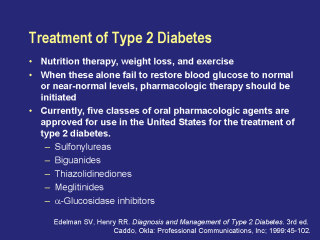| front |1 |2 |3 |4 |5 |6 |7 |8 |9 |10 |11 |12 |13 |14 |15 |16 |17 |18 |19 |20 |21 |22 |23 |24 |25 |26 |27 |28 |29 |30 |31 |32 |33 |34 |35 |36 |37 |38 |39 |40 |41 |42 |43 |44 |45 |46 |47 |48 |49 |review |
 |
Essential components of treatment for patients
with type 2 diabetes are nutrition therapy and regular physical activity.
Weight loss frequently is a primary goal of nutrition therapy in obese
patients with type 2 diabetes. When 3 months of dietary modification and exercise alone do not result in near-normalization of blood glucose levels, oral antidiabetic agents should be initiated as adjunctive therapy. In the United States, there are currently five classes of oral pharmacologic agents that have been approved for the treatment of type 2 diabetes. These include sulfonylureas, biguanides, thiazolidinediones, meglitinides, and alpha-glucosidase inhibitors. Edelman SV, Henry RR. Diagnosis and Management of Type 2 Diabetes. 3rd ed. Caddo, Okla: Professional Communications, Inc; 1999:45-102. |